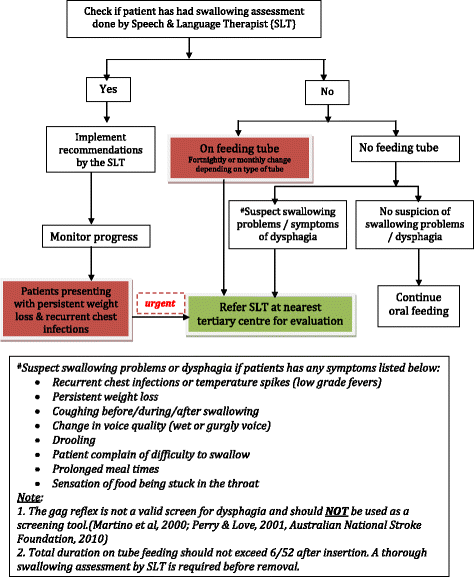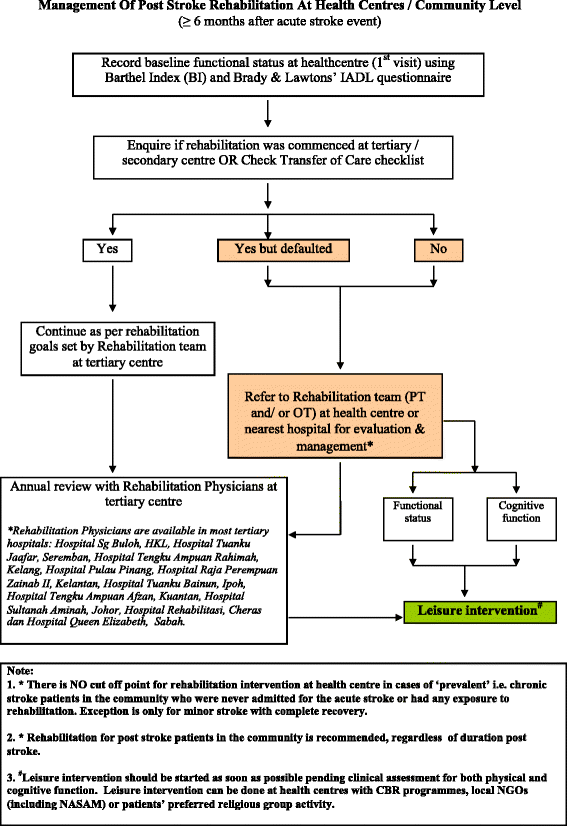The integrated care pathway for post stroke patients (iCaPPS): a shared care approach between stakeholders in areas with limited access to specialist stroke care services
- PMID: 28086871
- PMCID: PMC5237137
- DOI: 10.1186/s12913-016-1963-8
The integrated care pathway for post stroke patients (iCaPPS): a shared care approach between stakeholders in areas with limited access to specialist stroke care services
Abstract
Background: Lack of intersectoral collaboration within public health sectors compound efforts to promote effective multidisciplinary post stroke care after discharge following acute phase. A coordinated, primary care-led care pathway to manage post stroke patients residing at home in the community was designed by an expert panel of specialist stroke care providers to help overcome fragmented post stroke care in areas where access is limited or lacking.
Methods: Expert panel discussions comprising Family Medicine Specialists, Neurologists, Rehabilitation Physicians and Therapists, and Nurse Managers from Ministry of Health and acadaemia were conducted. In Phase One, experts chartered current care processes in public healthcare facilities, from acute stroke till discharge and also patients who presented late with stroke symptoms to public primary care health centres. In Phase Two, modified Delphi technique was employed to obtain consensus on recommendations, based on current evidence and best care practices. Care algorithms were designed around existing work schedules at public health centres.
Results: Indication for patients eligible for monitoring by primary care at public health centres were identified. Gaps in transfer of care occurred either at post discharge from acute care or primary care patients diagnosed at or beyond subacute phase at health centres. Essential information required during transfer of care from tertiary care to primary care providers was identified. Care algorithms including appropriate tools were summarised to guide primary care teams to identify patients requiring further multidisciplinary interventions. Shared care approaches with Specialist Stroke care team were outlined. Components of the iCaPPS were developed simultaneously: (i) iCaPPS-Rehab© for rehabilitation of stroke patients at community level (ii) iCaPPS-Swallow© guided the primary care team to screen and manage stroke related swallowing problems.
Conclusion: Coordinated post stroke care monitoring service for patients at community level is achievable using the iCaPPS and its components as a guide. The iCaPPS may be used for post stroke care monitoring of patients in similar fragmented healthcare delivery systems or areas with limited access to specialist stroke care services.
Trial registration: No.: ACTRN12616001322426 (Registration Date: 21st September 2016).
Keywords: Community based; Developing countries; Health care; Health services; Post stroke complications; Prevention of post stroke sequelae; Rehabilitation; Secondary prevention adherence stroke.
Figures




References
-
- World Heart Federation. The Global Burden of Stroke [Internet]. 2012. Available from: http://www.world-heart-federation.org/cardiovascular-health/stroke/. Accessed 1 Dec 2013.
Publication types
MeSH terms
Associated data
LinkOut - more resources
Full Text Sources
Other Literature Sources
Medical

